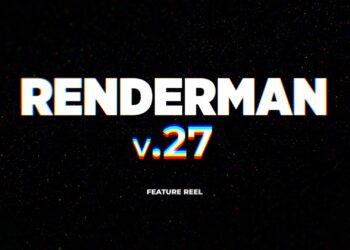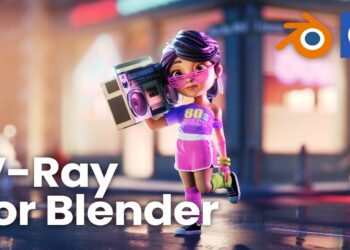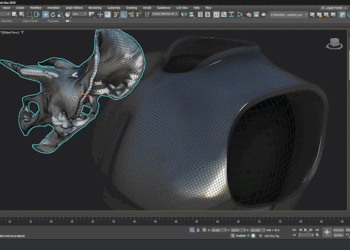Version 2.5 of LuxCoreRenderer has been released. The new version adds OptiX/RTX acceleration, non-uniform camera bokeh, new AOVs, randomised texture tiling and rotation, translation and scale. Also included are several new textures such as a wireframe map, a distort map, a brick texture capable of pseudo randomising colours per brick, a texture bombing map capable of randomly placing decals, and more.
BlenderLuxCore also gains OptiX viewport denoising and a new light group editor that allows the user to edit brightness and colour in a compositor node group alongside many more quality of life improvements.
LucCoreRender 2.5 is open source under the Apache License Version 2.0. Find out more on the LuxCoreRenderer website and read the list of new features in the release notes.









Bravo!
We’ve been working with 2.5 alpha and beta, it’s an amazing render engine, it’s evolving quite fast and it’s being kept (and will be kept) open source and free for everyone.
IMHO it has the best integration in Blender for a third party engine, it’s export speed it’s nearly the same as Cycles, so pretty good engine, with amazing capabilities, with more support it will evolve even faster.
Let me add that the developers are very committed to the project, and there is also a developer working in a 3dsmax integration, however I’m not sure what’s the status of it 🙂
Hi Juang, Luxcore is the most beautiful renderer for Blender – we use it in the University and all my students are more then happy with it. The results they make are astonishing! If you want I can send you some collages of the works, please contact me pm anytime.
(this is so far the best replacement for Vray)
Of course Igor!
I’ll do a live streaming about 2.5 tomorrow night, I would be glad to show your students results if I have permission 🙂
I will send you a message through the 3d-io contact form 🙂
What are the Pro and Cons in relation to Cycle?
It has GI caching ang good caustics
There are many, some objective, some subjective:
Pros:
Better suited for ArchViz, amongst other features it has different types of caches and light tracing, for better interior path tracing, fast caustics and better handling scenes with a huge amount of lights.
There are other pros, but they are more subjective (light we prefer the type of light treat in LuxCore for ArchViz), so I’ll leave it as this.
Shaders are powerful (they also have a con I’ll say later) and easy to use.
Lightgroups work massively well in LuxCore, we have them in our Blender build for Cycles, but default Cycles don’t have them yet.
Cons:
Since it’s an addon it tries to optimise as much as possible the export of the scene but there are things that cannot be optimised further for the time being, so some things are a bit slower to export than with Cycles.
It lacks some features for other workflows, like character animation, for example the subsurface scattering configuration is a pain for the time being (it should be solved when the Disney shader is upgraded), there is no deformation motion blur yet, the procedurality of materials are more limited in comparison to what you can do with Cycles, but it is more in line to what you can find in Max in Corona.
A lot more things can be said but I think these are the most important ones 🙂
Many thanks
Nice render engine for Blender but i did a small test with an interior room and cpu only. It doesn’t compare with Vray speed in any case with CPU, it doesn’t clean quickly the noise as in Vray/Corona and every time you move the camera it needs a few ~5 seconds to start showing in viewport the scene.
The test was with Blender 2.92, cpu threadripper 3950x.
Maybe I am wrong, but I see it today this way: it does not cost EUR 650 + 3dsMax EUR 1700 per Year. In midterms, it does not cost you € 11.500,- for 5 years, if you work alone in your room. As a studio, it does not cost me EUR 50.000,- for all seats and render-slaves. I eat this “5 seconds” for that money, worth it.
I am not criticizing Autodesk here (I am myself a passionate 3dsmax/vray user since 20 years), just pointing that the 5sec delay (?) is a good compromise for an alternative, free solution which delivers comparable visual results.
5 second for every IPR starting.. well if you are a professional who work 8hr/day it’s really a waste of time
Yes, this is true – if it the premise is true.
Adding numbers to prove the sum is lager is good only if you want to make the sum lager. You start IPR once per work session, why should I switch every few seconds to OpenGL mode and back to IPR? One does not close IPR in Vray every few clicks neither (and Vray RT takes sometimes AGES to load the scene in GMemory!). God knows what kind of 3d geometry GIanis has loaded in LuxCore to cause this delay, he has delivered absolutely no info, therefore his post is only a claim that we can not review and evaluate.
Btw. I have now tested a random 500.000 pol scene. There is no 5 second delay. With GTX2070 and with Ryzen 3700 it is all time instant. A test case should be good to continue comparisons. Till then, I stand to claim that LuxCore is an adequate alternative to existing, expensive solutions.
I agree regarding the cost difference, but as individual freelancer that I get paid for work this is not a barrier. Of course I would prefer to save that money 🙂 but the example I mentioned is one room with 10 furniture models and is really disruptive the export process every single time I move the camera and is slow on cleaning the noise with much indirect lighting.
On the same scene Cycles was much more responsive and the noise was clearing faster but didn’t have LuxRender image quality on the final render.
In my opinion LuxRender has amazing features that some miss from Cycles but it can’t be compared with Vray, is getting close though, if I couldn’t afford to purchase a renderer I would prefer to use LuxRender over Cycles as it produces very realistic result and the light passes looks very handful.
The halt with viewport render is true, not always happens, but in some scenes it may happen, it’s not about LuxCore, in this case it’s a Blender’s limitation that has to be improved.
Also if you use GPU for the viewport, the viewport responsiveness is worse due to come conversion required, also provoked by a limitation in the API I think, hopefully this may be solved in the Blender’s future.
So far for viewport CPU is the best option and the most responsive one.
Also the trick to put the viewport resolution to 2x is recommended for 4k or HiDPI screens because internally it does not scale automatically and it renders at 4k 🙂
A couple of things that can improve the viewport experience:
Beautiful stuff and it is pretty mind-blowing that this is completely free. It makes me wonder how these pieces of software ever can be sustainable. The hope is that this will develop continuously into the future, so money has to come from somewhere, right? Is it supposed to be supported by donations alone, or am I missing something?
It is possible there is some contract work going, but i am just speculating.
Not that I know.
LuxCore is currently being developed out of the willingness of the developers and donations to the initiative, here is the information 🙂 :
https://luxcorerender.org/donate/
Ok
i am nor a blender user, nor a luxcorerenderer user but i tried it. i had problem installing 2.5 so i downloaded the 2.4 and worked. i tried the “famous” caustics and that insane. real-time preview for the caustics with very sharp result.I was impressed! Good Job.
Blender 2.93 is now in Beta, so hope to see them make it work with that version.
2.5 MAY be made compatible with 2.93 at some point, but until 2.93 is fully released they won’t take a look at it